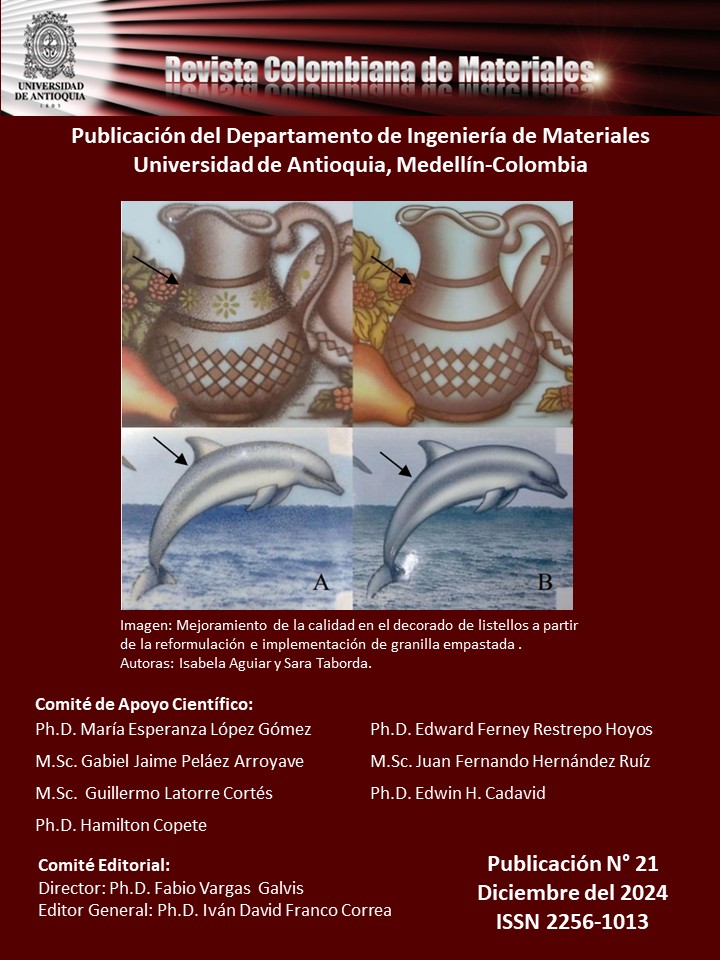Evaluation of the properties onbinary blendsof post-consumer mixed polymers with recycled polypropylene
DOI:
https://doi.org/10.17533/udea.rcm.n21a01Keywords:
Recycling, polyolefin blends, compatibility, PLAAbstract
Polyolefins make up a large proportion of the great post-consumer polymer stream. Due to their similar chemical and physical properties, it is difficult to collect and sort them separately, so it is common for them to be mixed during recycling processes, which is why they are called mixed recycled polyolefins. For this reason, it is important to obtain information about their thermal, rheological and mechanical behavior and to study how these properties vary in their blends, which will serve to predict their subsequent performance and their technical standardization, facilitating the recycling process. Thus, the objective of this work is to study the properties of binary blends ofrecycled polypropylene withrecycled mixed polyolefins, specifically high density polyethylene and low density polyethylene recycled in different proportions, without using compatibilising agents. In addition, blends of recycled polypropylene with recycled polylactic acid are studied as an alternative for 3D printing waste, a prevalentprocessing method for this polymer. Binary blends were made at 20, 40, 60 and 80% by weight using a twin-screw extruder and the properties of each blend were determined by infrared spectroscopy, differential scanning calorimetry, melt flow index measurements and tensile tests. The results revealed that although there was no miscibility, the polyethylene blends gradually increasedtensile strength with the addition of recycled polypropylene.
Downloads
References
ACOPLASTICOS, [Online], Available: https://acoplasticos.org/2024/09/12/plasticos-en-colombia-2024/, [Accessed: 25-Nov-2023].
Al-Juhani, A. A., Suleiman, M. A.,“Study of the Effect of EPDM Structure on the Compatibility of PP/LDPE Blends”, Arabian Journal for Science and Engineering, vol. 37, núm. 4, pp. 863–875, jun. 2012.
Al-Salem, S.M., Behbehani M.H., Al-Hazza’a, A., et al., “Study of the degradation profile for virgin linear low-density polyethylene (LLDPE) and polyolefin (PO) plastic waste blends”, Journal of Material Cycles and Waste Management, vol. 21, núm. 5, pp. 1106–1122, sep. 2019.
Aumnate, C., Rudolph, N., Sarmadi, M., “Recycling of polypropylene/polyethylene blends: Effect of chain structure on the crystallization behavior”, Polymers (Basel)., vol. 11, núm. 9, p. 1456, sep. 2019.
Cuiffo, M. A., Snyder, J., Elliott, A. M., Romero, N., Kannan,S., Halada,G.P., “Impact of the fused deposition (FDM) printing process on polylactic acid (PLA) chemistry and structure”, Applied Sciences, vol. 7, núm. 6, p. 579, jun. 2017.
Jones, H., McClements, J., Ray, D., Hindle, C. S., Kalloudis, M., Koutsos, V., “Thermomechanical properties of virgin and recycled polypropylene—high-density polyethylene blends”, Polymers (Basel), vol. 15, núm. 21, p. 4200, oct. 2023.
Karaagac, E, Jones, M.P., Koch, T., Archodoulaki, V.-M., “Polypropylene contamination in post-consumer polyolefin waste: characterisation, consequences and compatibilisation”, Polymers (Basel), vol. 13, núm. 16, p. 2618, ago. 2021.
Kukaleva, N., Simon, G. P., Kosior, E., “Binary and ternary blends of recycled high‐density polyethylene containing polypropylenes”, Polymer Engineering & Science, vol. 43, núm. 2, pp. 431–443, feb. 2003.
Nagarajan ,V., Mohanty, A. K., Misra, M., “Perspective on Polylactic Acid (PLA) based Sustainable Materials for Durable Applications: Focus on Toughness and Heat Resistance”, American Chemical Society Sustainable Chemistry and Engineering, vol. 4, núm. 6, pp. 2899–2916, jun. 2016.
OECD, “Projections of the environmental impacts of the plastics lifecycle to 2060,” In: Global Plastics Outlook: Policy Scenarios To 2060, OECD Publishing, 1st ed, ch. 6, Francia, 2022.
PLASTICS EUROPE, [Online], Available: https://plasticseurope.org/es/wpcontent/uploads/sites/4/2023/02/PLASTICOSSITUACION-2022-esp.pdf, [Accessed: 23-Nov-2023].
Posch, D. W., “Polyolefins”, In: Applied Plastics Engineering Handbook, M. Kutz, 2nd ed, ch. 2, Elsevier, USA, 2017.
Stuart, B., Infrared Spectroscopy: Fundamentals and Applications, John Wiley & Sons, New Jersey, 2004.
Sutar, H., Sahoo, P.C., Sahu, P.S., et al., “Mechanical, thermal and crystallization properties of polypropylene (PP) reinforced composites with high density polyethylene (HDPE) as matrix”, Materials Sciences and Applications, vol. 09, núm. 05, pp. 502–515, 2018.
Vervoort, S., Doelder, J., “Compatibilization of polypropylene–polyethylene blends”, Polymer Engineering and Science, vol. 58, núm. 4, pp. 460–465, abr. 2018.
Vollmer, I., Jenks, M.J.F.,Roelands, M.C.P., et al., “Beyond mechanical recycling: giving new life to plastic waste”, Angewandte Chemie International Edition , vol. 59, núm. 36, pp. 15402–15423, sep. 2020.
Downloads
Published
How to Cite
Issue
Section
License
Copyright (c) 2025 Revista Colombiana de Materiales

This work is licensed under a Creative Commons Attribution-NonCommercial-ShareAlike 4.0 International License.








